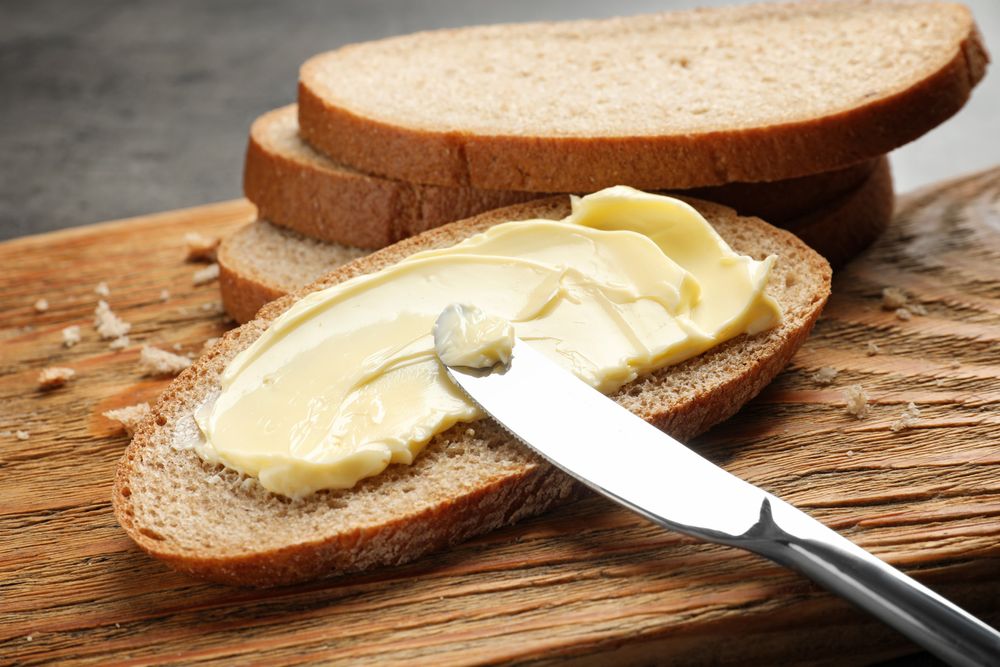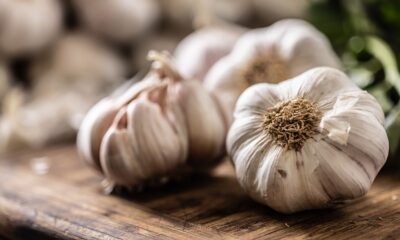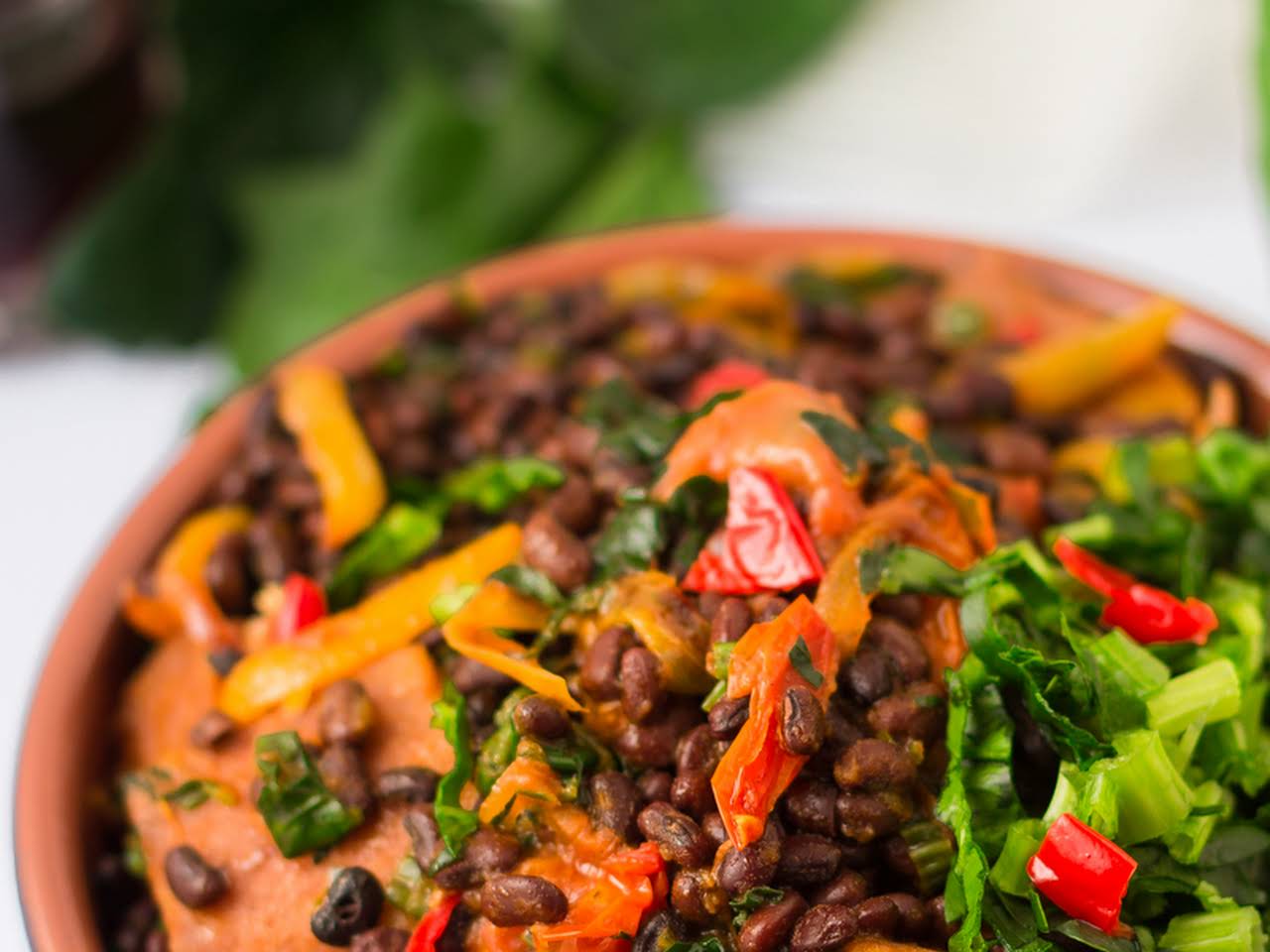FOOD
4 Healthy Alternatives To Butter
Published
1 year agoon

Butter, a popular ingredient in baking recipes, is rich in saturated fat, which can raise LDL cholesterol, a risk factor for heart disease. The American Heart Association recommends reducing saturated fat intake to less than 6% of daily calories. In a 2,000-calorie diet, 1 tablespoon of butter contains over 7 grammes of saturated fat, making 2 tablespoons over the daily limit.
While butter is delicious, many people may want to replace it with another ingredient to reduce calories, make the food heart-healthy, follow a certain diet, or have a severe lactose intolerance or milk protein allergy.
Butter alternatives can also be used to control weight and maintain a healthy diet. By experimenting with butter alternatives, you can still enjoy the texture and taste of butter-based recipes while reducing fat and increasing nutritional value.
What are the healthy alternatives to butter?
1. Avocado provides a creamy texture and heart-healthy fat
This rich fruit is indispensable in your recipes. Avocado contains heart-healthy fat and nearly 20 vitamins and minerals. Mashed avocado is a great substitution for butter in recipes that call for chocolate or cocoa. Its creamy texture and mild flavour pair well with the sweetness of chocolate.

Also, the dark colour of chocolate hides the green avocado well. Avocado works great in cookies, but it may make them a touch green unless you use a darker kind, such as double chocolate or gingerbread.
A recent study found that increasing avocado intake to 14 per week enhanced adults’ total physical activity by 27%. This suggests that avocados may be beneficial for heart health in multiple ways.
According to the researchers, this finding could be explained by avocados’ therapeutic compounds, which may help alleviate discomfort, causing individuals to feel better and move more.
2. Yoghurt is creamy and offers a punch of protein
One advantage of substituting butter with yoghurt, particularly Greek yoghurt, is that it has the same creamy mouthfeel as butter due to its thickness. Start by replacing half the butter in a recipe with yoghurt; the other half should be a fat like avocado oil.

According to studies, ¾ cup of Greek yoghurt contains 15 g of protein, providing a protein boost to your meals. A new assessment suggests that fermented dairy meals, such as yoghurt, may be better absorbed by the body than nonfermented milk products.
Fat not only adds texture to baked items but also serves as a stabiliser. Using yoghurt (or fruit like bananas) instead of butter or oil reduces its shelf life and causes it to spoil faster. All the more reason to devour it quickly, right?
Get the latest and greatest updates right away! Join our exclusive WhatsApp channel and never miss out on exciting news again.
3. Mashed bananas provide blood-pressure-friendly potassium
One cup of mashed bananas has 734 milligrams (mg) of potassium, which is approximately 17% of the recommended intake. Potassium helps regulate blood pressure, according to the National Institutes of Health.

In baking, bananas combine the creaminess of avocados with sweetness. You should replace half of the fat in your dish with bananas, with an overall 1:1 ratio. To make 1 cup of butter, combine ½ cup of mashed banana with ½ cup of butter or oil.
Of course, bananas will impart a fruity, banana-like flavour to the completed product.
4. Nut butter is a creamy way to boost fibre and protein
Nut butter, such as peanut, almond, or cashew, is an excellent substitute for butter. It is fairly firm at room temperature and gives baked foods a texture akin to butter. You could also add more fibre and protein to the recipe.

When you first try a dish, substitute half of the butter with your favourite nut butter. If it goes well, use more of the nut butter.
Eating more nuts, including nut butter, may lessen the chance of developing atherosclerosis, which is the formation of fatty plaque in arteries.
Butter alternative you may think twice about
While not the healthiest option, there is one more butter alternative:
Coconut Oil
Coconut oil has a delicious, tropical taste that some people appreciate. However, it is high in saturated fat, making it not the most heart-healthy alternative.
Check out more articles on food here.
You may like
-


4 Tips For A Stress-Free Cooking Experience This Christmas
-


5 Ways To Stay Healthy This Christmas Season
-


5 Health Benefits Of Cooking With Garlic
-


Are Alcoholic Drinks Only Harmful? See Surprising Health Benefits
-


How To Stay Healthy While Boosting Productivity
-


Here’s The Best Recipe For Making Rice Fritters
FOOD
4 Tips For A Stress-Free Cooking Experience This Christmas
Published
1 month agoon
December 22, 2024
The Christmas season is a time for joy, family, and delicious meals. However, cooking can often feel overwhelming, especially with the holiday hustle. With the right approach, cooking Christmas meals can be a stress-free experience.
Here are four practical tips for a stress-free cooking experience this Christmas.
1. Plan Ahead for Every Detail
Preparation is the key to success in the kitchen. Start by creating a detailed menu. Write down the dishes you want to make, the ingredients you need, and the estimated time for each recipe. This planning ensures you stay organised.
Invest time in grocery shopping early. Stores can be crowded closer to Christmas, so getting what you need in advance helps avoid the rush.
Batch-process tasks like peeling vegetables or marinating meat a day or two before. Following these tips for stress-free cooking keeps last-minute chaos at bay.
2. Simplify Your Menu
Christmas meals don’t need to be extravagant to be memorable. Focus on a few key dishes that everyone loves rather than a spread that leaves you exhausted. Choose recipes that are easy to prepare and don’t require constant attention.
For desserts, consider make-ahead options like pies or cookies. These can be prepared in advance, allowing you to spend more time with your guests. Simplifying your menu is one of the best tips for stress-free cooking this Christmas.
3. Use Time-Saving Tools and Techniques
Modern kitchen gadgets are lifesavers during Christmas. Slow cookers, food processors, and stand mixers can help speed up the process while reducing effort.
For large meals, use your oven efficiently. Bake multiple dishes at once if they require the same temperature. Pre-chop ingredients or buy pre-cut options to save valuable time.
Embrace these tips for stress-free cooking to make your holiday meal prep smoother and faster.
4. Delegate and Involve Others
You don’t have to do everything yourself. Share the workload with family or friends. Assign simple tasks like setting the table, washing vegetables, or stirring sauces to others.
If guests offer to bring a dish, accept their help. Potluck-style dinners reduce your cooking burden while adding variety to the table.
Delegating responsibilities is among the most effective tips for stress-free cooking, ensuring you enjoy the process too.
Cooking for Christmas doesn’t have to be a source of stress. By planning ahead, simplifying your menu, using time-saving techniques, and involving others, you can create a joyful and memorable meal.
These four tips for stress-free cooking will not only lighten your load but also let you focus on the true spirit of the season: togetherness and gratitude.
Keep these strategies in mind as you prepare your holiday feast. Merry Christmas and happy cooking!
For more reads, visit here.

Akidi (black beans) recipes are a cornerstone of Enugu State’s culinary heritage, enjoyed widely across Nigeria and Africa. This versatile legume, rich in protein, fibre, and essential vitamins, makes it a nutritious staple in many homes.
Originating from Enugu, akidi holds a special place in traditional dishes, offering robust flavour and health benefits.
If you’re looking to expand your cooking repertoire, these three delicious akidi (black beans) recipes will elevate your meals.
Whether you’re an experienced chef or a kitchen novice, each akidi (black beans) recipe provides a unique taste experience.
Embrace the richness of Enugu’s culture and impress your family with these flavourful and nutritious dishes featuring the beloved black beans.
Recipe 1: Classic Akidi Soup
Ingredients:
- 1 cup dried black beans (akidi)
- 1 large onion, chopped
- 2 scotch bonnet peppers, chopped
- 2 tablespoons palm oil
- 1 teaspoon dried crayfish
- 1 teaspoon salt
- 1/2 teaspoon black pepper
- 1 stock cube
- Water
Instructions:
- Soak the beans: Rinse the black beans and soak them in water overnight.
- Cook the beans: Drain the soaked beans and add them to a pot with fresh water. Bring to a boil, then reduce heat and simmer until the beans are tender.
- Sauté the aromatics: Heat the palm oil in a separate pot. Add the chopped onion and scotch bonnet peppers, and sauté until fragrant.
- Combine the ingredients: Add the sautéed ingredients to the pot of cooked beans. Stir in the dried crayfish, salt, black pepper, and stock cube.
- Simmer and serve: Simmer the soup for an additional 10-15 minutes, or until the flavours are well combined. Serve hot.
Recipe 2: Akidi with Spinach and Plantain

Ingredients:
- 1 cup cooked black beans (akidi)
- 1 bunch spinach, chopped
- 2 ripe plantains, sliced
- 1 onion, chopped
- 2 cloves garlic, minced
- 1 teaspoon ginger, grated
- 1 teaspoon curry powder
- 1/2 teaspoon turmeric powder
- Salt to taste
- Vegetable oil
Instructions:
- Heat the vegetable oil in a pot. Add the onion, garlic, and ginger, and sauté until fragrant.
- Add the spinach: Add the chopped spinach to the pot and stir until wilted.
- Combine the ingredients: Add the cooked black beans, curry powder, and turmeric powder to the pot. Stir to combine.
- Fry the plantains: In a separate pan, fry the plantain slices until golden brown.
- Serve: Serve the akidi and spinach mixture with the fried plantains.
Recipe 3: Akidi with Smoked Fish and Vegetables

Ingredients:
- 1 cup cooked black beans (akidi)
- 1 smoked fish, crumbled
- 1 large onion, chopped
- 2 carrots, diced
- 1 green bell pepper, diced
- 1 teaspoon thyme
- 1/2 teaspoon black pepper
- Salt to taste
- Vegetable oil
Instructions:
- Heat the vegetable oil in a pot. Add the onion, carrots, and bell pepper, and sauté until softened.
- Add the beans and smoked fish: Add the cooked black beans and crumbled smoked fish to the pot. Stir to combine.
- Season and simmer: Season with thyme, black pepper, and salt. Simmer for 10-15 minutes, or until the flavours are well-combined.
- Serve: Serve the akidi with smoked fish and vegetables hot with rice, yam, or bread.
These three akidi (black beans) recipes are just a starting point. Feel free to experiment with different ingredients and flavours to create your own unique dishes.
Remember, the key to a delicious akidi dish is to use high-quality ingredients and to cook slowly to allow the flavours to develop.
Whether you’re a seasoned cook or a novice in the kitchen, these akidi (black beans) recipes are a great way to enjoy this nutritious and flavourful legume.
For more articles on food recipes, visit here.

Garlic is more than just a flavour enhancer; it offers numerous health benefits that have been celebrated for centuries. Incorporating garlic into your meals not only enriches the taste but also boosts your overall well-being.
Let’s explore five key health benefits of garlic, emphasising why this simple ingredient deserves a spot in your kitchen.
1. Boosts Heart Health
Garlic is renowned for its heart-protective properties. It helps lower blood pressure and reduces cholesterol levels, which are crucial factors in maintaining cardiovascular health.
Allicin, a compound found in garlic, relaxes blood vessels, improving blood flow and reducing the risk of heart disease.
Regular consumption of garlic may also prevent artery hardening, a condition known as atherosclerosis. Clearly, one of the primary health benefits of garlic is its contribution to a healthy heart.
2. Strengthens the Immune System
Garlic acts as a powerful immune booster. Its antibacterial, antiviral, and antifungal properties help the body fend off infections. Rich in antioxidants, garlic combats free radicals that can damage cells and contribute to illness.
Cooking with garlic regularly can support your immune system, making it more resilient against common colds and flu. This vital health benefit of garlic makes it a natural defence mechanism.
3. Improves Digestive Health
Garlic promotes healthy digestion by stimulating the production of digestive enzymes. Its antimicrobial properties can help balance gut flora, reducing harmful bacteria and promoting beneficial ones.
Additionally, garlic may reduce inflammation in the gut, alleviating symptoms of conditions like irritable bowel syndrome (IBS).
Including garlic in your diet can improve overall digestive function, emphasising another essential health benefit of garlic.
4. Enhances Bone Health
Surprisingly, garlic may also support strong bones. It contains minerals like calcium, manganese, and selenium, which are vital for bone density and strength.
Some studies suggest that garlic consumption can increase estrogen levels in women, potentially reducing the risk of osteoporosis.
This lesser-known health benefit of garlic highlights its role beyond the kitchen, contributing to long-term skeletal health.
5. Supports Detoxification
Garlic aids the body’s natural detoxification process by activating liver enzymes that help eliminate toxins. Its sulfur compounds enhance liver function, enabling the body to flush out heavy metals and harmful substances more efficiently.
Regularly cooking with garlic can provide a natural cleanse, supporting overall vitality. This detoxifying health benefit of garlic underscores its importance for maintaining internal balance.
Incorporating Garlic into Your Diet
Maximise these health benefits by adding garlic to soups, stir-fries, and sauces. Crush or chop it and let it sit for a few minutes before cooking to enhance its beneficial compounds.
Remember, the health benefits of garlic are most potent when it’s used fresh and minimally cooked.
Cooking with garlic not only elevates your culinary creations but also offers significant health advantages. Embrace this versatile ingredient and enjoy the multiple health benefits of garlic with every meal.
Would you like more articles or additional tips? Check here.
Latest


5 Things To Expect In Afrobeats In 2025
Afrobeats is poised to reach unprecedented heights in 2025 as Nigerian music continues its remarkable global ascent. The genre’s explosive...


Here Are The 7 Most Ancient Countries On Earth
The oldest countries in the world stand as remarkable testaments to human civilisation, each containing landscapes and monuments that narrate...


Why Self-Reflection Is More Important Than Resolutions
Millions of people embark on a yearly ritual: they sit down with a notebook and pen, eager to craft a...


Nollywood Director, Kemi Adetiba Teases King Of Boys 3
Nollywood director Kemi Adetiba has revealed that another instalment of King of Boys will be released on December 25, 2025....


John McEnroe Says He Can Be The Commissioner Tennis Needs Amid Doping Crisis
Recent doping controversies involving top players have not damaged tennis’s reputation, but John McEnroe believes that appointing a single commissioner...


“Everybody Loves Jenifa” Becomes Nollywood’s Highest-Grossing Film Of All Time
Nollywood filmmaker Funke Akindele has achieved a historic milestone with her latest film, “Everybody Loves Jenifa.” The film has officially...


FG To Premiere TV Series, “Hidden Riches” On Mining Sector On January 25
Nigeria’s Federal Government will launch an ambitious television drama series focused on the nation’s mining sector, premiering “Hidden Riches” on...


Qing Madi Delivers A Soulful Performance Of “Favourite Pyscho”
Rising Afro-RnB sensation Qing Madi launches into 2025 with a mesmerising performance on the prestigious COLOURS platform, showcasing her latest...


Taiwo Awoniyi’s First Goal Of The Season Seals Nottingham Forest’s Win Over Wolves
Taiwo Awoniyi made a triumphant return to Premier League action. He scored in stoppage time to help Nottingham Forest crush...


Tems, Ayo Edebiri, Wizkid & More Nominated For The 56th NAACP Image Awards
The 56th NAACP Image Awards have unveiled their nominations. It highlights various exceptional talents. These talents include Nigerian stars Tems,...
-Ad-




Police Deny Knowledge & Investigation Of VeryDarkMan’s Missing N180m

Funke Akindele Breaks Records Again As “Everybody Loves Jenifa” Surpasses ₦1 Billion In 12 Days

Speed Darlington’s ₦300m Rights Suit Against I-G Set For Hearing January 13

Cobhams Asuquo’s Birthday Look Exudes Cinematic Vibe

Paul Okoye And Wife Ifeoma Dedicate Baby Girl At Church

Olamide & Asake Officially Part Ways; Alleged Details Of Contract Termination Emerge

Emerse Fae Insists Simon Adingra Must “Work Hard” To Emulate Drogba In Premier League

Amad Diallo Determined To “Make History” With Struggling Manchester United

5 Reasons You Should Cut People Off Before 2025



